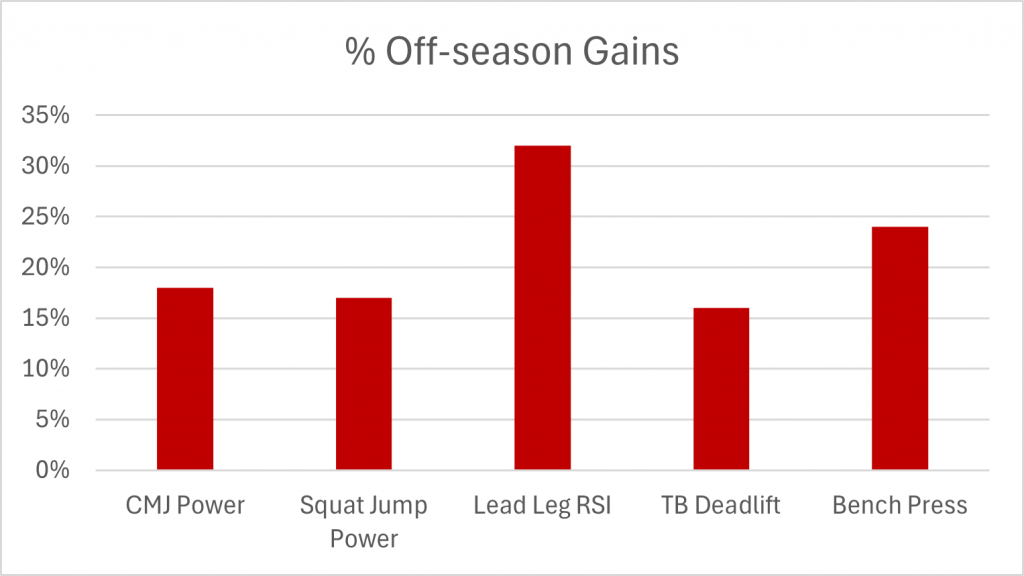
After 15 years of training baseball players of all ages and levels, I can tell you with the highest degree of certainty that the purpose of a great off-season baseball strength training program is to:
-
- Increase explosive power
- Create more efficient movers
- Build more durable athletes
While different athletes will always require more of one of these adaptations than the other, when focusing on the youth population (13-18 year olds) the deciding factor is almost always:
-
- Increasing lean body mass
- Increasing absolute strength
Is your off-season strength program working for you? Let’s get into it…
The purpose of this study is to evaluate the efficacy of our off-season strength training program. This will include data regarding lean body mass (LBM), upper and lower body strength / power as well as deceleration ability of the lead leg, which considering that we train over 150 pitchers during a typical off-season is pure gold as far as metrics are concerned.
Methods
Over 40 randomly selected high school baseball pitchers training at RPP (age range 16-18) were selected and evaluated during the off-season via a combination of 5 different testing protocols:
-
- Body Composition / Lean Body Mass
- Strength – Deadlift and Barbell Bench Press
- Lower Body Power – Jump Testing (both CMJ and Squat jump)
- Upper body Power – Proteus Motion
- Lead Leg Deceleration Ability – S. Leg Drop Jump
Each participant received a full movement assessment, as well as an individualized training program based on each athlete’s baseline strength, power, and plyometric abilities. Programming was progressed monthly based on our off-season periodization model, as well as re-testing if deemed necessary.
Baseline Testing was performed with 2 re-tests being performed 8 weeks apart to get mid off-season and end of off-season data as well. Let’s take a further look.
1. Body Composition / Lean Body Mass
I generally believe that Body Composition is one of the most vital components of an athlete’s profile when it comes to throwing velocity or bat speed. Simply put, throwing a baseball, or hitting one is just about transferring momentum from your body to the baseball and, those athletes with high levels of lean body mass (under 15% body fat) have more POTENTIAL to transfer higher amounts of momentum to reach a higher velocity ceiling. That simple.
Below are the results of our average LBM gains. This shows a gain of 6% or essentially 10 lbs. but- taking into consideration that most athletes lost between 3-5% body fat during this process, this equates to gains of closer to 15 lbs. of muscle. Additionally, athletes who began their off-season training in September (vs. November), it’s not uncommon to see an even higher gain, closer to 20-25 lbs.!
-
- Baseline – 174 lbs.
- Mid-point – 179 lbs.
- End – 184 lbs.
2. Strength
A stronger athlete is better able to:
-
- Create higher amounts of force
- Improve acceleration (rate of force development or RFD)
- Better attenuate force (deceleration)
- Facilitate the proper muscular recruitment patterns (i.e., using more lower half than rotator cuff) to generate higher levels of velocity)
For example, a pitcher will be much more aware of using his lower body if he becomes more aware that he has one! In addition, the posterior chain (hamstrings and glutes) is among the biggest and most powerful muscles in the body. If you are wondering how to increase pitching velocity, let me be very clear, you must increase your lower body strength.
Taking a look at our roster’s off-season strength data, we saw significant improvements in both their upper and lower half strength numbers.
Deadlift (average) – 16% gain from baseline to end
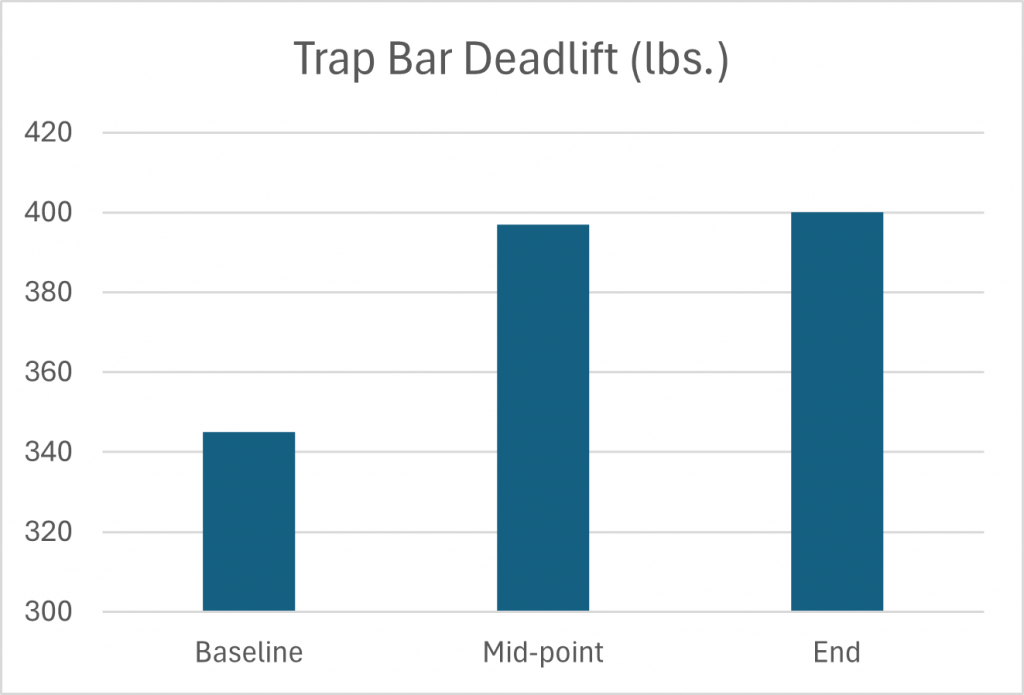
Bench Press (average) – 24% gain from baseline to end
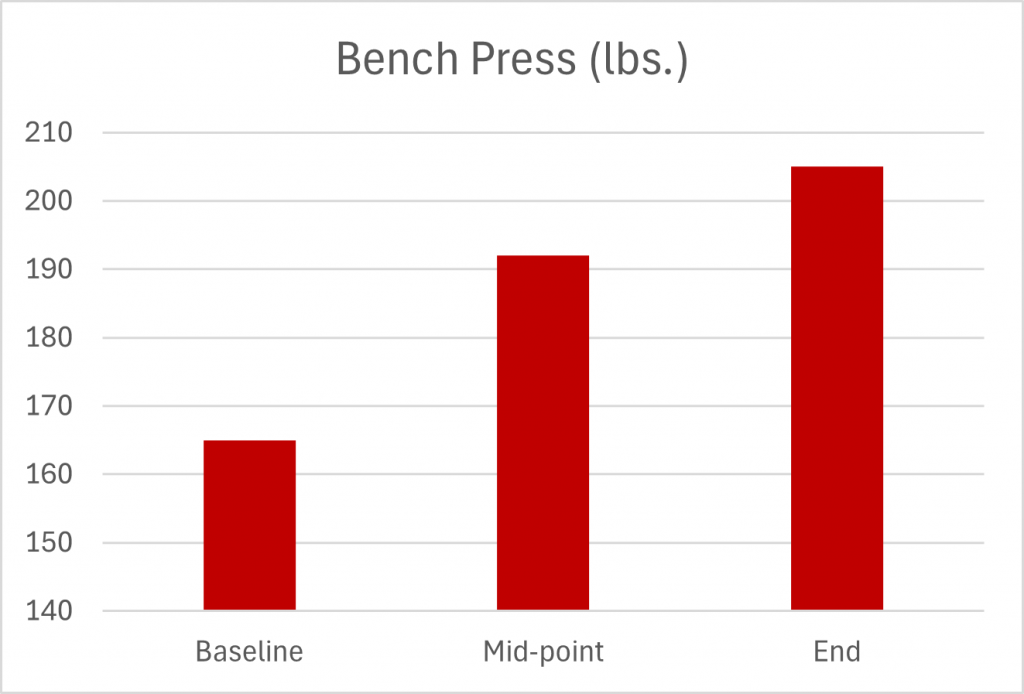
An athlete cannot possess high levels of power without having good relative strength. This is why the highest amount of these pure strength gains generally come in the first half of the off-season when absolute strength is the main priority in our program’s periodization prior to training power.
For athletes with a lower training age, we will keep them in a strength focus the entire off-season. But for most, we will progress to training power, which brings us to data topic #3… POWER!
3. Lower Body Power
Once we increase force production through training strength, we now have to learn to apply our newly found strength quickly. In other words, become more powerful or explosive. In a rotational sport like baseball, we need to look at power in two parts, lower body, and upper body. Let’s begin with Lower Body Power.
We initially evaluate lower body power using 2 types of jumps. The first is a CMJ jump. This lets us know how well the athlete utilizes their stretch shortening cycle (elasticity). The second is a squat jump which tells us how much of the jump is sheer muscular force. Every athlete creates power differently. Some use more elasticity, some more muscular force. The magic lies in giving the athlete more of whichever he needs, strength or elasticity, without taking away what he is already good at.
CMJ Jump
Below are the results of our lower half power testing, from baseline to mid-point and the end or late off-season, representing a 17-18% improvement from beginning to end.

4. Upper Body Power
Power is plane specific, and baseball happens in the transverse / rotational plane. As a result, we use the Proteus Motion as a way to assess power and acceleration. due to its ability to train with adequate resistance in the strength-speed and speed-strength zones (i.e., “power”) as well as in the transverse plane.
Up until now, this type of training has only been possible through the use of med balls, which do not create enough resistance through a FULL range of motion. Here is a look at Proteus.
Proteus Trunk Rotation
Below are the results of our upper body power testing from baseline to mid-point and finally late off-season (measured in watts)…
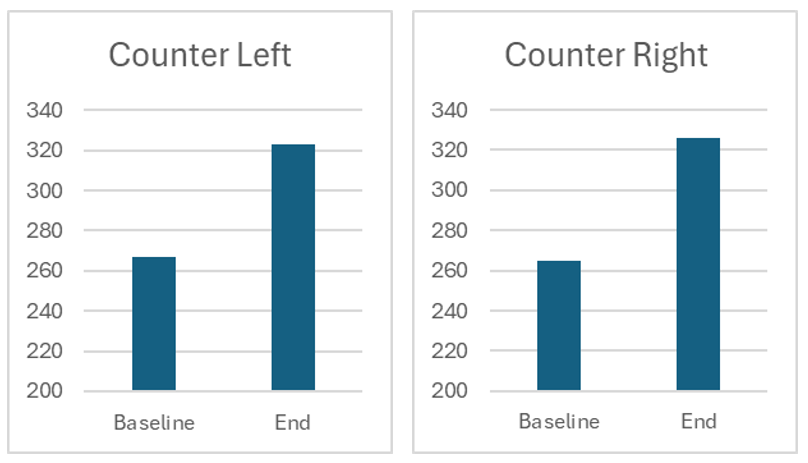
Counter Rotation – Left and Right Side
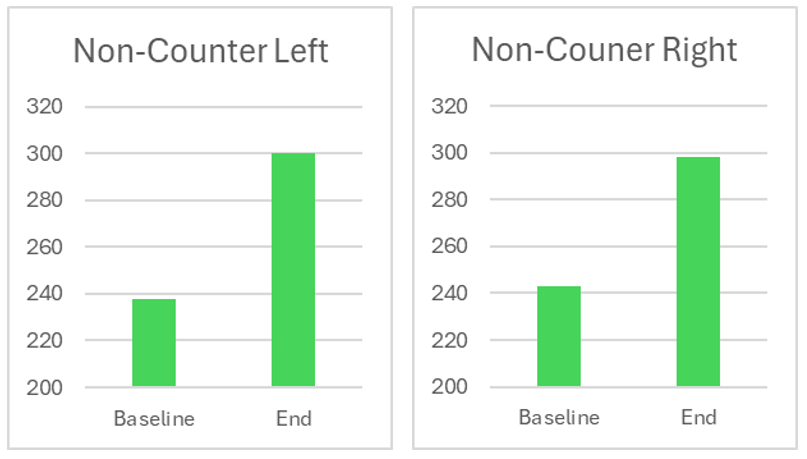
Non-Counter Rotation – Left and Right Side
5. Lead Leg Deceleration
This is otherwise known as “Eccentric Strength”, or the ability of the athlete’s lead leg to hit the brakes immediately at foot plant. This sudden stopping of forward momentum causes the hand and forearm to fly backward before bouncing back and unloading with great arm speed with much less having to be produced by the arm or elbow.
We use what we call a Single Leg Depth Drop from a 4” riser (to simulate the slope of the mound), onto a jump mat or force plate to record contact time and divide it by jump height to calculate what we call a S. Leg RSI Test
S. Leg RSI Test
Based upon the results, we can try possible heel first or flat foot landings with the lead leg to better help a faster deceleration and ultimately faster post up.
A score of >.90 tells us the athletes plyometric / declarative ability is high enough to warrant a “flat foot” landing. This type of landing allows for greater deceleration, but ONLY if the athlete can handle the eccentric load.
Below are the results of our upper body power testing baseline -mid and late off-season, demonstrating a 32% gain from 0.76 to 1.00.
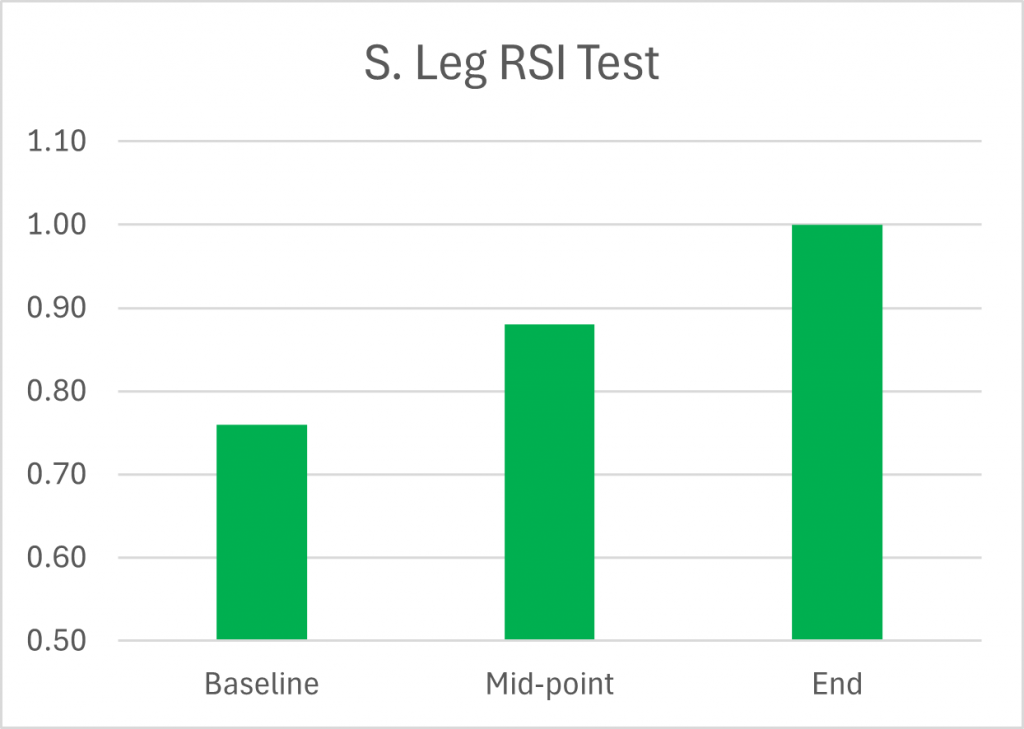
Conclusions
Following the 20-week off-season program, our athletes showed significant gains in lean body mass, increases in both upper and lower body strength and power as well as increased plyometric / decelerative ability of the lead leg. A summary of these results can be seen below.

Additional training and improvements in anterior and rotary core control as well as improvements in tissue quality and posterior cuff strength and stability leaves us on the edge of our seats waiting for opening day. This is when we get to see all of our athlete’s hard work be put to work.
See ya’ in the gym…
By Nunzio Signore
You live too far to train with us in-house at RPP? You can now train with us on a REMOTE basis.


